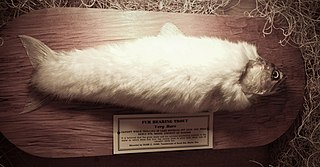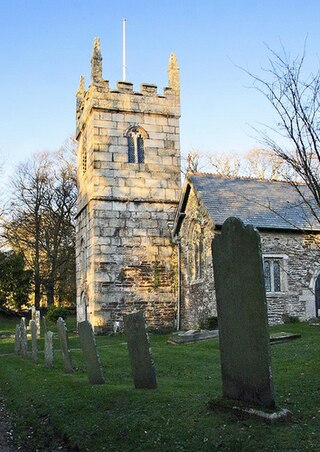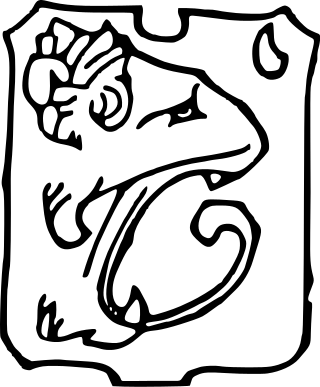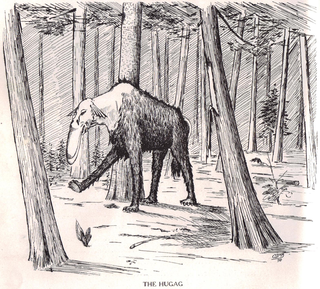
In American folklore, a Sidehill gouger is a fearsome critter adapted to living on hillsides by having legs on one side of their body shorter than the legs on the opposite side, having evolved to resemble any form of mammals such as pangolins, goats, humans, and bears. This peculiarity allows them to walk on steep hillsides, although only in one direction; when lured or chased into the plain, they are trapped in an endless circular path. Some claim these creatures play a large role in, and in some cases are responsible for, the creation of hoodoos. The creature is variously known as the Sidehill Dodger, Sidehill Hoofer, Side-hill Gazink, Sidehill Ousel, Sidehill Loper, Sidehill Galoot, Gyascutus, Sidewinder, Wampus, Boofum, Gudaphro, Hunkus, Rickaboo Racker, Prock, Gwinter, or Cutter Cuss.

Rhinelander is a city in and the county seat of Oneida County, Wisconsin, United States. The population was 8,285 at the 2020 census.
American mythology is the body of traditional stories pertaining to America's most legendary stories and folktale, dating back to the late 1700s when the first colonists settled. "American mythology" may also refer to the modern study of these representations, and to the subject matter as represented in the literature and art of other cultures in any period.

The jackalope is a mythical animal of North American folklore described as a jackrabbit with antelope horns. The word jackalope is a portmanteau of jackrabbit and antelope. Many jackalope taxidermy mounts, including the original, are made with deer antlers.

In South Jersey and Philadelphia folklore in the United States, the Jersey Devil, also known as the Leeds Devil, is a legendary creature said to inhabit the forests of the Pine Barrens in South Jersey. The creature is often described as a flying biped with hooves, but there are many variations. The common description is that of a bipedal kangaroo-like or wyvern-like creature with a horse- or goat-like head, leathery bat-like wings, horns, small arms with clawed hands, legs with cloven hooves, and a forked or pointed tail. It has been reported to move quickly and is often described as emitting a high-pitched "blood-curdling scream".

The fur-bearing trout is a legendary creature found in American folklore and Icelandic folklore. According to folklore, the trout has created a thick coat of fur to maintain its body heat. Tales of furry fish date to the 17th-century and later the "shaggy trout" of Iceland. The earliest known American publication dates from a 1929 Montana Wildlife magazine article by J.H. Hicken. A taxidermy furry trout produced by Ross C. Jobe is a specimen at the Royal Museum of Scotland; it is a trout with white rabbit fur "ingeniously" attached.

In Cornish folklore, the Owlman, sometimes referred to as the Cornish Owlman, or the Owlman of Mawnan, is an owl-like humanoid creature said to have been seen in 1976 in the village of Mawnan, Cornwall, UK. Reported sightings of it flying above the church tower have led some to believe the creature may have been a barn owl, a species that commonly nests in such places.
The Beast of Bray Road, is the name given to a wolf-like creature allegedly reported to have been witnessed in or near Elkhorn, Walworth County, Wisconsin. The creature has become a part of Wisconsin folklore and has been the subject of multiple books, documentaries and a 2005 horror film.

Fearsome Creatures of the Lumberwoods, With a Few Desert and Mountain Beasts is a 1910 fantasy field guide by William Thomas Cox (1878–1961), Minnesota’s first State Forester and Commissioner of Conservation, with illustrations by Coert du Bois and Latin classifications by George Bishop Sudworth The text is a noteworthy resource on folklore, as a century after its initial publication Fearsome Creatures remains one of the principal sources on legendary creatures of the United States and Canada.
The splintercat is a legendary fearsome critter in the folklore of the United States.

In North American folklore and American mythology fearsome critters were tall tale animals jokingly said to inhabit the wilderness in or around logging camps, especially in the Great Lakes region. Today, the term may also be applied to similar fabulous beasts.

In American folklore, the axehandle hound is a fearsome critter of Minnesota and Wisconsin.

The Hidebehind is a nocturnal fearsome critter from American folklore that preys upon humans that wander the woods, and was blamed for the disappearances of early loggers when they failed to return to camp. As its name suggests, the Hidebehind is said to be able to conceal itself. When an observer attempts to look directly at it, the creature quickly hides behind an object or behind the observer and therefore cannot be directly seen. The Hidebehind supposedly uses this ability to stalk human prey without being observed and to attack them without warning. Said victims, including lumberjacks and others who frequent the forests, are then dragged back to the creature's lair to be devoured. The creature subsists chiefly upon the intestines of its victim and has a severe aversion to alcohol, which is therefore considered a sufficient repellent. Tales of the hidebehind may have been used as an explanation of strange noises in the forest at night. Early accounts describe Hidebehinds as large, powerful animals, despite the fact that no one was able to see them.

A legendary creature is a type of fantasy entity, typically a hybrid, that has not been proven and that is described in folklore, but may be featured in historical accounts before modernity.
In American folklore, the Gumberoo is a fearsome critter with hide so tough that bullets bounce off of it.

The Goofus bird is a mythical, backwards-flying bird, originating in lumberjack folklore in North America. It is also known variously as the Filla-ma-loo bird or the Flu-fly bird.
The Walgren Lake Monster is a cryptid of varying description reported in Walgren Lake near Hay Springs, Nebraska.

In American folklore, the hugag is a fearsome critter similar to a moose with an extensive upper-lip, preventing it from grazing, and joint-less legs preventing it from lying down.
William Thomas Cox (1878–1961) was the first State Forester and Commissioner of Conservation for Minnesota. Cox worked as a forester for the United States Forest Service prior to his appointment as State Forester. After leaving office, in 1929, Cox traveled to Brazil to organize the Brazilian Forest Service including exhaustive exploration of the Amazon Basin. Returning to the United States in 1931, Cox was appointed as the first Commissioner of Conservation for Minnesota.
















